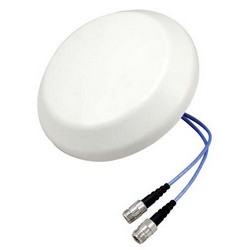What it is:
Passive Intermodulation (PIM) is a type of signal interference in a wireless system. PIM can be a problem in almost any wireless network, but it can really wreak havoc on distributed antenna system (DAS) and LTE networks. DAS networks are used to distribute cellular and Wi-Fi signals throughout a building or area, and LTE networks support high-speed wireless access for mobile phones, tablets, and other mobile wireless devices. With both technologies supporting many of our wireless devices, it has become increasingly important to detect and lessen PIM’s effects.
Why it happens:
PIM is caused by nonlinearities in the passive mechanical components of a wireless system such as antennas, cables, and connectors, especially in places where two different metals come together. As nonlinearities increase, so do PIM signals. PIM in the transmission path degrades the quality of the wireless communication system. Damaged RF equipment or even nearby metal objects such as guy wires and anchors, roof flashing and pipes can also be sources of PIM.
Additionally, PIM can be caused by two or more carriers sharing the same downlink path in a wireless network. This practice is becoming more common as wireless networks become increasingly complex with multiple technologies and technology generations at a single site. When two signals combine, it causes signal interference and can significantly impact the performance of DAS and LTE networks.
How it is measured:
PIM is measured in decibels relative to the carrier (dBc) or decibel-milliwatts (dBm). Levels near -100 dBm or less are generally considered good, but the lower the better. Tests have shown that when PIM levels were increased from -125 dBm to -105 dBm there was an 18% drop in download speeds, even though 105 dBm can be considered an acceptable PIM level.
How to protect your network:
Individual components such as low-PIM DAS antennas are often tested for PIM during the design and production processes to make sure that they are not significant PIM sources once they’re installed. In the case of a DAS, sometimes the entire system is tested for PIM as well as the individual components. Installation also plays a critical role because proper connections are necessary to keep PIM levels to a minimum.
PIM is also assessed during the cellular site placement process. Ideally, this happens before the cell site and antennas are positioned as well as during the installation process.
Plus, an increasing amount of test companies are offering specialized equipment to detect, pinpoint and address PIM sources. There are also low-PIM rated products now available to help keep PIM at bay.
PIM-certified equipment is becoming more common. For example, antennas may be PIM-certified to a level of -140 dBm and those requirements are becoming increasingly strict.
With so many devices dependent on strong wireless signals, PIM could throw a wrench in the system. Fortunately, there are steps that can be taken to identify and prevent the adverse effects of PIM.
Explore our range of low-PIM connectivity products.


